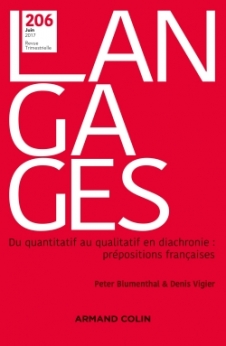
Langages n° 206 (2/2017)
Pour acheter ce numéro, contactez-nous
Recevez les numéros de l'année en cours et accédez à l'intégralité des articles en ligne.
Dans cet article, nous étudions les constructions [commencer/continuer à + infinitif]1 et [commencer/continuer de + infinitif]2, afin d’établir ce qui détermine le choix entre les deux. Nous analysons le pouvoir explicatif et prédictif de deux hypothèses, une hypothèse phonétique d’après laquelle l’emploi de la construction 2 serait lié à l’évitement du hiatus, et une hypothèse sémantique d’après laquelle l’emploi de la construction 1 serait favorisé en contexte télique. Nous le faisons à partir d’une large étude sur corpus en diachronie, mettant à profit, d’une part, les bases de textes disponibles (BFM, Frantext, Presto), d’autre part, les outils lexicométriques et statistiques. Nos résultats confirment largement l’hypothèse phonétique, qui permet de rendre compte d’une large part de variation dans les données, et faiblement l’hypothèse sémantique, qui ne semble tenir que pour certaines périodes.
This paper is a diachronic corpus study of an alternation between two French constructions, [commencer/continuer à + infinitive]1 and [commencer/continuer de + infinitive]2. Our goal is to establish what determines the choice between the two. We propose two hypotheses, namely a phonetic one –that the use of construction 2 is linked to an effect of hiatus avoidance–and a semantic one –that construction 1 appears preferentially in telic contexts. To test the predictive power of these hypotheses, we submit our corpus data to qualitative, lexicometric and statistical analyses. Our results confirm the validity of the phonetic hypothesis, which accounts for much of the variation in the data, but they provide only partial support for the semantic hypothesis, which only holds for certain historical periods.

